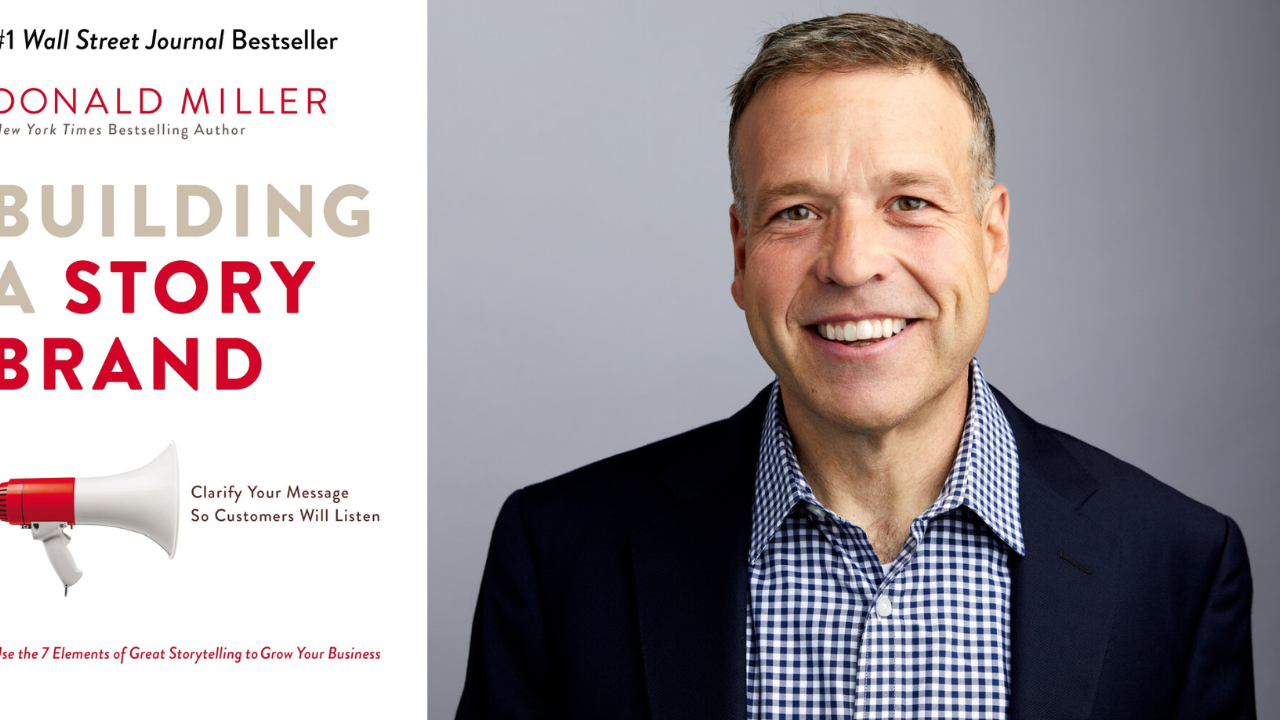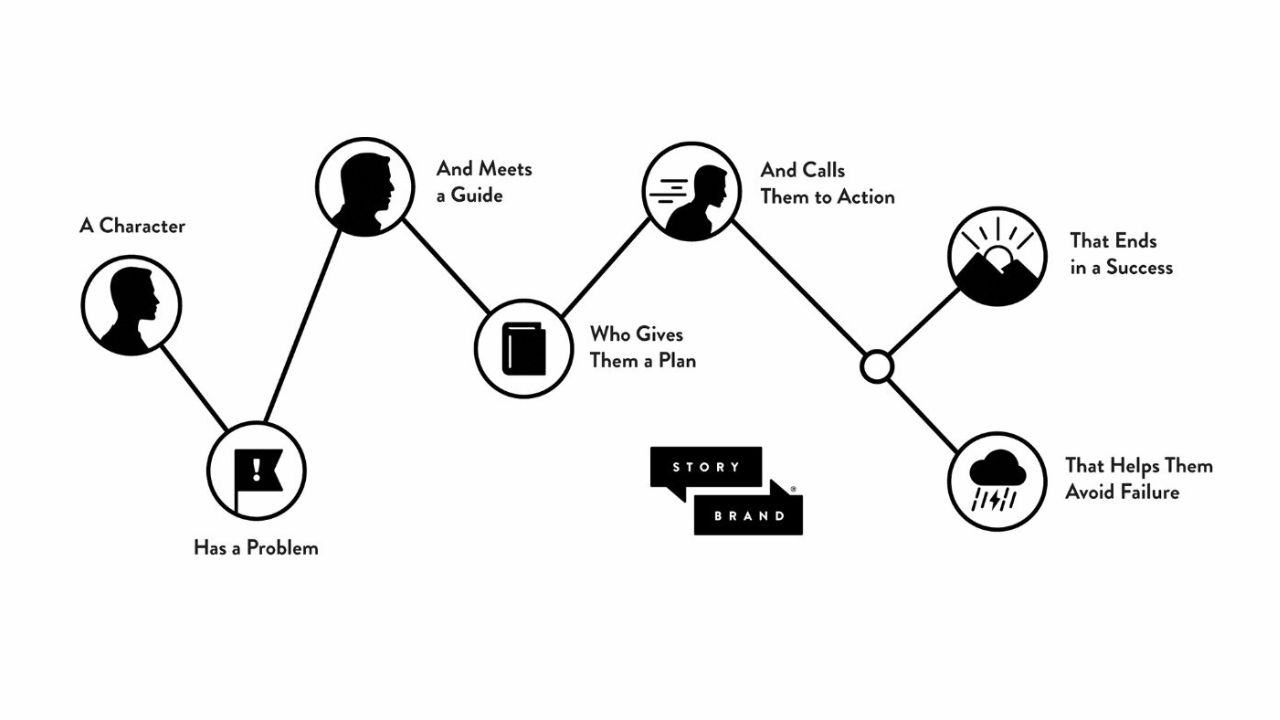Everything You Need To Know About A StoryBrand BrandScript (+ Examples For Small Business Owners)
As a small business owner, it can be difficult to create an effective marketing message that resonates with your target audience and stands out in the marketplace.
With customers being hit with thousands and advertisements and pitches each day you need to be able to quickly showcase how you can help them solve their problem as it relates to your business and win.
However that can be easier said than done, but thankfully there is a proven framework that you can follow to create a clear message that your customers will listen to and engage with called a StoryBrand BrandScript.
StoryBrand framework provides an easy-to-follow framework for developing and delivering messaging that will make your message crystal clear. This powerful tool can equip you with the tools and knowledge you need to effectively tell your story and create a brand that resonates with customers.
In this article, we'll provide an overview of StoryBrand BrandScript, explain how it works, show the best StoryBrand Website examples, and offer some examples of effective StoryBrand BrandScripts for small business owners.
With the StoryBrand framework by your side, you’ll be able to craft a powerful story that resonates with your customer base and drives business growth.
What is StoryBrand?
StoryBrand is messaging framework that helps small business owners clarify their marketing message so that their customers will listen and their business will grow.
With this StoryBrand framework, small business owners and marketers can easily create their copy got websites, emails, social media content, sales funnels, presentations, sale pitches, and any other marketing collateral with confidence.
It was created by author Donald Miller and uses the timeless principles found in storytelling to help businesses and brands create a story to invite their customers into.
Who is Donald Miller?
Donald Miller - an acclaimed author, motivational speaker, CEO, and marketing guru - is the mastermind behind StoryBrand.
He has penned several bestsellers such as Blue Like Jazz and Marketing Made Simple, Business Made Simple, and Hero on A Mission along with personal essays about faith & spirituality.
His latest book How To Grow Your Small Business provides a 6-step plan to help entrepreneurs take their businesses to new heights!
What Is a StoryBrand BrandScript?
A StoryBrand BrandScript aka StoryBrand Framework is a messaging framework that helps small business owners create a clear, compelling message for their customers.
The BrandScript consists of 7 components:
A Character (your customer) wants something, but there is a problem(External, internal & philosophical) that is keeping them from getting it.
Then they meet a guide (your business) that shows them they understand what it's like to deal with that problem (empathy) but that they have found the solution and helped others just like them resolve that problem (authority).
This guide then shows them the plan (the 3-step process) and calls them to action (If you don't call your customers to action they most likely never will.
So that they can avoid failure (all the bad things they are currently dealing with and that could soon happen) and experience success (all the great things that are waiting for them once they get this problem solved).
StoryBrand BrandScript provides a powerful framework for creating messaging that will resonate with your customers and drive growth for your business. By following this StoryBrand method, you can craft an effective message that will help you stand out and get results!
How Do You Make a StoryBrand Framework? Parts of A BrandScript
Now let's dive in a little deeper to better understand each part of the BrandScript so that you can see how this helps to invite your prospective customers into a compelling story.
Character
Most businesses think that it's all about them. I am sorry to tell you it's not...
The main character in a BrandScript is NOT YOUR BUSINESS.
You are not telling your story which is where most businesses miss the mark. You are telling your customer's story.
It's time to recognize the truth - you are the main character in your own personal story. The same holds for your customers, so why should their experience be any different?
The Most Important Question Your Business Should Have An Answer For
Now the character part of your story is not your avatar or the demographics of your customer, it's more about their desires.
The most simple way to understand your customers and to create the character for your story is to answer this question from your customer's point of view.
"I want ________."
When you can answer, "what does my customer want?" you will be well on your way to writing a story that your customers want to be a part of.
Pro Tips & Common Mistakes
Use THEIR words. Don't try to get too cute and clever or use any insider language that only people in your industry would understand. Use the words your customers would say and say it just like they would.
Your customer doesn't WANT what you are selling....sorry...
They may NEED that to get what they want but that's not what they really WANT.
Example: If you are a gym, your customers do not WANT a gym, personal training, or a fitness program. What they WANT is to lose 10 lbs, to be able to run pain-free, increased energy, or to improve health markers.
Talk about what they WANT and NOT what you are trying to sell.
Problem
A story does not get interesting until there is a conflict that is introduced by some type of problem.
Your customer(character) WANTS something but there is a problem that is keeping them from getting what they want.
3 types of problems
That problem has 3 different levels external, internal, and philosophical.
As you dig deeper into the pain points of your customers lives, your company will go from just another brand to creating SuperFan customers for life!
The External Problem
This is the main thing your customer is dealing with and the easiest one to identify.
What is the one big thing as it relates to your company's products and services that is keeping your customers from getting what they want?
Examples:
They have low back pain
They are paying too much in taxes
They are dealing with legal issues
They can't sell their house
They have an unclear brand message & inconsistent marketing results
The Internal Problem
Once you understand the external problem, it's time to dig deeper into the internal problem.
This is how that problem is making them FEEL.
The internal problems are where we start to connect with our potential customers.
Examples:
Overwhelmed
Stressed
Fearful
Anxious
Hopefully, you are not feeling any of these now, but don't worry we are going to keep digging in to show you how this all comes together soon!
The Philosophical Problem
This is where you take someone from just being interested in what you do to creating brand champions that are ready to tell everyone about your business.
This is where you describe why this is just plain wrong that they are having to deal with this issue.
This is typically something that starts with
You shouldn't...
You ought...
You deserve…
Or we believe...
This is getting them to buy into the bigger cause of what you do.
Examples:
We believe your finances shouldn’t hold you back from living life to the fullest.
We believe having a body you feel good in at any age is within reach.
Eating healthy ought to be easy and sustainable
You deserve to have legal protection without breaking the bank.
I believe your marketing should be simple, consistent, scalable and get results.
Love this quote
"If you can describe your customer's problem better than they can, they will automatically assume you have the answer." Russell Brunson
Be Their Guide
This is when you are introduced to your character (customer) but NOT as the hero, but as the guide that is there to show them the way.
What is the Guide section of a StoryBrand?
Customers don't need a hero, they require a guide.
That is why it's essential to exhibit that you are focused on THEM and their needs - because without guidance, customers would be unable to solve the issues confronting them in the first place.
StoryBrand BrandScripts introduce another character here:
The guide — whose sole purpose is to support the hero so they can conquer any obstacles.
We become these guides by demonstrating empathy toward our customer’s predicament while whatsoever inspiring trust through authority and experience.
Empathy & Authority
You must have BOTH of these in place However, they must be in balance with each other.
Empathy
This is where you show your customers that you are listening and you understand.
This is the "be more human" section.
So many businesses have become "experts" in their field that they forget what it's like to be in their customer's shoes and fail to see things from their customer's perspectives.
You can easily show empathy by saying something that starts like this:
“I know how hard it is to deal with …”
“Many of my clients have struggled with…”
“Don’t you just hate it when….”
“I understand how it feels to…”
“Like you, I am troubled by…”
Examples:
We know how stressful it can be to try to keep track and make sense of all your expenses and earnings
We know how it feels to be overwhelmed and not know where to start
Many of my clients have struggled with letting small legal events pile up to expensive issues that could have easily been resolved had they addressed them sooner.
I know how frustrating it can be to see others in your industry have more success online just because they were better at marketing what it is they do.
Authority
Demonstrating your expertise is essential in order to be successful.
Make sure you illustrate that you are well-versed in the area and capable of solving the problem at hand; there's no need for overconfidence or excessive authority. Just make certain they can trust that you know what needs to be done.
Examples:
Stats
Awards
Media Appearances
Testimonials & success stories (You need 3 AWESOME & specific results you helped them achieve. But we cover this in over blog posts)
Most of the time you shouldn’t talk about yourself too much, however, if your personal story shows both of these you can include it.
So What's The Plan?
Customers trust a guide who has a plan.
Your customers want a clear path that avoids confusion about how they need to do business with you, and how they will get results.
At this juncture in our customers' journey, they stand to potentially forfeit money, time and respect if they make a purchase.
To prevent that from happening, instead of following through with their decision-making process - more often than not - consumers will find ways to talk themselves out it by thinking "this is too hard" or "I'm just not getting it." Consequently postponing the purchasing phase indefinitely.
A straightforward plan encourages customers to understand the ease of doing business with us. By itemizing our offering (including the narrative we invite them into) in uncomplicated steps, customers feel more comfortable and are likely to take action right away.
The 3 Steps To Get This Problem Solved
I LOVE a good 3-step plan.
You can add more than 3 steps but never more than 5 to your plan section.
There are tons of studies around this but know this if you can't easily explain in 3 steps the actions your prospective clients need to take to do business with you...it's too confusing and they will not take action.
Here is a perfect example
StoryBrand Accounting firm example:
Schedule a call
Create a customized wealth plan that minimizes your taxes
Confidence your wealth plan is in place
Law Firm StoryBrand Example
Schedule a call
Get your legal game plan
The confidence you are protected
BONUS: Can you dub this process plan with a title that emphasizes its worth? For instance, how about "The Quality Partner Plan" or "The Customer Appreciation Program"?
Call Them To Action
If we don't take the initiative to challenge our customers, they will never make any purchases. This means we have to communicate a clear and direct call to action.
It should involve communicating how our product can help them overcome their challenges and make their life easier.
Till we actively ask them to do something, they won't bother engaging with us. But when we directly ask for an action, it increases our chances of making a sale.
If we don’t feel confident enough to ask people to buy from us, they will assume that our product isn't the right solution for them.
Types CTAs (Call To Action)
Direct calls to action are the ONE THING our customer needs to do.
This should be CLEAR, DIRECT, & CONSISTENT.
We cover CTA's a lot in other blog posts so be sure to check them out.
Quick tip
Make sure the call to action button is on the top right of your website and you write the same CTA over the entire website page.
Transitional calls-to-action (lead generators) should establish trust by immediately solving a problem that your customers are facing.
Call to action button examples:
Direct
Schedule a call
Buy Now
Transitional (aka Lead Generators)
Legal Business Blueprint guide
Hormone Quiz
Marketing Domination Checklist
We must help our character avoid failure
People are driven by two key forces: the fear of failure and the desire for success.
In our marketing, it's important to define what our customers could lose if they don't take action with our brand.
Describing negative consequences and reminding them of their pain points can be a great way to encourage people to engage with us.
However, we must be careful not to scare them away by being too overbearing. Oftentimes, the fear of failure is a greater motivator than the prospect of achieving success.
Don't be too negative
When thinking about the failure part of our messaging we don't want to go too negative or too far in the future. Just a few words will do. You can even list them as bullet points on your site.
It needs to be something they can feel and imagine. When you go too big it's just fear-mongering and that's not the point.
Our goal is just to remind them of what they will continue to deal with if they don't get this problem resolved.
Examples:
Wondering if you are managing your budget right
Missing out on life
Letting your competition pass you by
Wasting money on marketing that doesn't work
Continue to wake up each morning in pain
Success - What does happily ever look like?
People need to know that their lives can look different when they choose your brand.
Show your potential customers the value proposition and vision of how they can expect life to be better, with tangible solutions to the issues they face.
Utilize both text and beautiful images to illustrate how your product or service resolves its difficulties in a value stack.
Let them see the positive transformation they can experience when they trust you as an authority in their journey.
How much to include?
With failure we don't want to overdo it, however with success, we want lots of it!
We want to show them the short team benefits of getting this problem solved as well as all the long-term relief they will experience and how much better life will be once this problem has been solved.
This is a fantastic way to show how you help your customers win, your value proposition, and close the story loop on a good story.
Examples
Create a value stack of all your service offerings but position them as solutions to problems and not just things you do.
Increased strength and mobility
Confidence in your body
Create a legacy of wealth
Peace of mind regarding all legal issues
Putting it all Together - A Good StoryBrand BrandScript Example
Here is how everything can fit together in a unified brand story that is engaging and invites your potential customers in and shows them their is hope and a future for them.
StoryBrand Certified Guide Sean Garner Consulting Brand Story
So you are a small business owner that wants to build a successful business and be seen as the go-to expert in your industry or niche.
To do that, you need a marketing plan that consistently works to bring in new leads, grow your business & showcase your expertise.
The problem is you are too busy running your business to consistently focus on your marketing and even if you made the time to work on it, have no idea where you should be spending your time or what you should be doing to get new business.
This makes you feel frustrated that others in your industry are viewed as leaders when you have more experience and knowledge than they do.
I believe your marketing should be simple, consistent, scalable, and get results and make the real experts DOMINATE their industry!
I know how frustrating it can be to see others in your industry have more success online just because they were better at marketing what it is they do.
You are a true expert and deserve to be viewed and sought out as one without having to spend all day creating the latest “TikTok dance trend video”
That is why I have worked with hundreds of business owners to build the Market Domination Plan that grows their business and helps them to stand out as the leaders in the industry or niche.
Here’s how it works.
Step 1 - Schedule a call. Pick the time that works best for you so we can discover more about your business, the goals you have for it and if we would be a good fit to work together.
Step 2 - Get your game plan. I will design a step-by-step marketing plan specific to YOUR business, YOUR goals, and YOUR schedule.
Step 3 - Execute & Dominate! Together we will implement the plan to get consistent leads coming in and position YOU as THE leader in your industry & niche utilizing storytelling marketing.
So schedule a call, so you can stop wasting time on marketing that doesn’t work and start growing your business and be seen as the clear leader in your industry.
StoryBrand Website Examples
Here are some StoryBrand website examples from some of our clients to inspire you and see how your story can be told to your website visitors.
I may be biased, but I do believe these are the best StoryBrand Website examples. They all follow the StoryBrand Framework and do a fantastic job following the StoryBrand principles not only on their website copy but across all their messaging.
If you are looking for an excellent example to follow check them out!
RestoreU Wellness - Functional Medicine Clinic StoryBrand Website
Ashley Vargas - Online Powerlifting Coach StoryBrand Website
Measured Home Services - Real Estate Appraiser StoryBrand Website
Why must small business owners use StoryBrand BrandScripts & StoryBrand Websites?
Creating a BrandScript allows small business owners to create a clear message that stands out and resonates with their core audience. StoryBrand’s 7-part framework helps make your brand story engaging, relevant, and persuasive.
This gives you a plan
StoryBrand guides you through the process of crafting a story focused on your customer's journey toward a resolution which can be used in a variety of marketing materials.
Creating an effective BrandScript that will make it easier for customers to understand who you are and what you do and unify your team around a common message so that everyone is speaking the same language.
It only works if you use it
Using StoryBrand's 7-part framework is an excellent way for small business owners to create a powerful brand story that will engage with your core audience and make it easier to convert leads into paying customers.
StoryBrand also helps you craft a unified message across all of your marketing materials, allowing customers to recognize and remember you more quickly.
With StoryBrand's 7-part framework, small business owners can now create an effective BrandScript that is the key to unlocking their business’s potential and achieving marketing success.
How to build your own StoryBrand BrandScript?
Read building a StoryBrand (Do it by yourself)
In Building a StoryBrand, Donald Miller teaches marketers and business owners to use the seven universal elements of powerful stories to dramatically improve how they connect with customers and grow their businesses.
Subscribe to Business Made Simple ( Do it by yourself)
These are online courses designed to help small business owners know everything they need to grow their businesses. They are taught by Don Miller and self-paced to walk you through this process along with other aspects of growing your small business.
Get a 7 day all access FREE trial HERE.
Attend a Live Workshop (Do it with someone else)
You can attend a StoryBrand in-person or virtual workshop to work alongside a certified StoryBrand Guide to help you with your BrandScript as you write it. This is a done-with-you experience. Register HERE for a StoryBrand LiveStream event.
Hire A Certified StoryBrand Guide (Done for you)
This is what I recommend for busy small business owners that want confidence their marketing is done right.
Creating a StoryBrand BrandScript can be overwhelming, but we are here to help companies just like you clarify their message so their business grows and they dominate their industry.
By working with StoryBrand Guide like me at Sean Garner Consulting, you will have all the tools to create an effective and powerful brand story that will engage and convert customers.
We build the best StoryBrand websites and are 100% confident we can grow your business and showcase you as the go-to guide in your industry.
Take the first step to unlocking your business’s potential today and schedule a call with me, so I can help you create an effective StoryBrand BrandScript that will help you stand out from your competitors and grow your business.
Let’s work together to position YOU as THE leader in your industry.
















